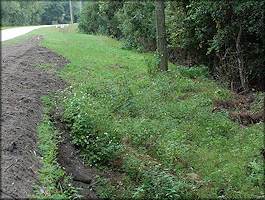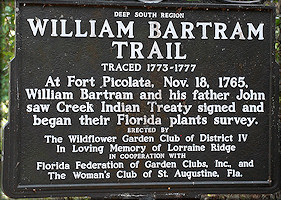|
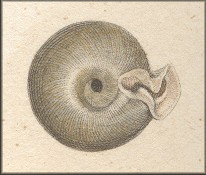 On April 6,
2007 Ed Cavin and I (Harry Lee) set out to find an authentic specimen of the
type species of Daedalochila. We had a very specific quarry
in the cross-hairs - the snail that America's first native-born
conchologist named Polygyra auriculata, the Ocala Liptooth.
Say (1818: 276) wrote: "This curious species we found near St.
Augustine, East Florida, in a moist situation. They were observed in
considerable numbers ..." Say never illustrated his snail, but an
early engraving (Binney,
1857: pl. 47, fig. 1 - see image, left) was consulted. The text and figure gave us a bit of reassurance for the
feasibility of our mission, but, after nearly 200 years, we expected
to encounter a considerable loss of suitable habitat and other
environmental degradation. The expedition certainly wasn't a
pre-ordained slam-dunk. To improve our chances of success, a closer
look at the history of Say's discovery was in order. On April 6,
2007 Ed Cavin and I (Harry Lee) set out to find an authentic specimen of the
type species of Daedalochila. We had a very specific quarry
in the cross-hairs - the snail that America's first native-born
conchologist named Polygyra auriculata, the Ocala Liptooth.
Say (1818: 276) wrote: "This curious species we found near St.
Augustine, East Florida, in a moist situation. They were observed in
considerable numbers ..." Say never illustrated his snail, but an
early engraving (Binney,
1857: pl. 47, fig. 1 - see image, left) was consulted. The text and figure gave us a bit of reassurance for the
feasibility of our mission, but, after nearly 200 years, we expected
to encounter a considerable loss of suitable habitat and other
environmental degradation. The expedition certainly wasn't a
pre-ordained slam-dunk. To improve our chances of success, a closer
look at the history of Say's discovery was in order.
In the autumn of 1817 Say set sail from Philadelphia, where,
at age 40 he was one of the members of the nascent Academy of
Natural Sciences (ANSP), only in its fifth year of existence. In the
company of naturalists William Maclure, George Ord, and Titian R.
Peale he made his way to Charleston and Savannah, where the group
chartered a 30 ton sloop, which eventually took them into the St.
Johns River (Lee, 1976). On Jan. 30, 1818, Say wrote from St.
Mary's, Georgia: "... we shall be off in about three or four days
for the promised land, a portion of which is now in sight. Our plan
is to ascend as far as convenient the River St. Johns, pursuing
pretty much the track of Bartram, my excellent and ingenious
relative" (Weiss and Ziegler, 1931: 55-56). [Pioneer Florida
naturalist William Bartram was Say's great uncle and William's
father, John, was his enate great grandfather.] Later Say
wrote "This noble river we ascended as far a Picolata, an old
Spanish fortress now in ruins, about 100 miles [a considerable, but
unintentional exaggeration] from its mouth ... From Picolata we
crossed the country on foot to St. Augustine" (Weiss and Ziegler,
1931: 58; also see the plaque shown below, which includes a
tribute to late Jacksonville Shell Club veteran member Lorraine
Ridge).
That was probably in late Feb. or March, 1818. Fast Forward
to April, 2007 and look, as we did, at another historical plaque
(illustrated below) positioned at the SE corner of the intersection of SR 13
(The Bartram Trail, blazed by Say's excellent and ingenious
relative) and the western terminus of CR 208. Judging from Say's
narrative and the plaque's indication, it seems a near certainty
that the latter highway follows the course of the carriage road
taken by Thomas Say and his co-expeditioners from Picolata to St.
Augustine. We drove all twenty miles of CR 208 to the heart of the
nation's oldest city. The road passes through potato fields, other
agricultural land, pine flatwoods, low deciduous forest, and
swampland. The last few miles are heavily developed, with commercial
and residential real estate dominating the landscape.
Our collecting strategy was to respectfully place ourselves
in the shoes of Say, Maclure, Ord, and Peale. "Near St. Augustine" is
a bit imprecise, but it indicates that the snail was not taken in
the city that the expeditioners knew. That left
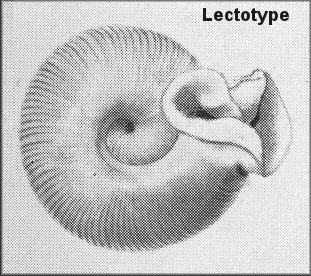 the stretch of 208
from the Old City to Picolata. Accordingly we stopped the car at
fairly regular intervals along CR 208, debarking at whenever "a
moist situation" which seemed to have promise was seen. In the
course of three hours no less than ten stations were made. At one
station some dead shells were found (along with a well-nourished
Pygmy Rattlesnake), but none of the other stops produced any
specimens (of D. auriculata that is; a Water Moccasin was
encountered, however). In near exasperation, we returned to the one
productive spot and, after nearly an hour of searching - without
re-encountering the rattlesnake - a living specimen of the Ocala
Liptooth was found in the grassy swale bank along the road.
Measuring a little over a half-inch, this snail is included, along
with a dozen empty shells of its species, in the accompanying
montage of illustrations. We believe these shells qualify as
topotypes (specimens collected in the same place of the type lot), which
imparts a certain authenticity to their identity. Furthermore, they
are dead ringers for the lectotype, which Say brought back to
Philadelphia in the Spring of 1818 (ANSP
57066a; plate 4; Pilsbry, 1940: fig. 384-1 - see image, above, left). Also see:
Compendium of
Daedalochila type material - a pictorial gallery (page one) the stretch of 208
from the Old City to Picolata. Accordingly we stopped the car at
fairly regular intervals along CR 208, debarking at whenever "a
moist situation" which seemed to have promise was seen. In the
course of three hours no less than ten stations were made. At one
station some dead shells were found (along with a well-nourished
Pygmy Rattlesnake), but none of the other stops produced any
specimens (of D. auriculata that is; a Water Moccasin was
encountered, however). In near exasperation, we returned to the one
productive spot and, after nearly an hour of searching - without
re-encountering the rattlesnake - a living specimen of the Ocala
Liptooth was found in the grassy swale bank along the road.
Measuring a little over a half-inch, this snail is included, along
with a dozen empty shells of its species, in the accompanying
montage of illustrations. We believe these shells qualify as
topotypes (specimens collected in the same place of the type lot), which
imparts a certain authenticity to their identity. Furthermore, they
are dead ringers for the lectotype, which Say brought back to
Philadelphia in the Spring of 1818 (ANSP
57066a; plate 4; Pilsbry, 1940: fig. 384-1 - see image, above, left). Also see:
Compendium of
Daedalochila type material - a pictorial gallery (page one)
Among historic experiences in field biology, this Spring,
2007 expedition to a place less than an hour distant may be a bit on
the mundane side, but to the two of us it was a triumph. Doing our
homework, braving the hazards of snake envenomation, and exercising
a modicum of tenacity paid off. A piece of Thomas Say's legacy is
reawakened after nearly two centuries of quiet repose, and we 21st
century "pioneers" experienced the hunt, with all its passion and
suspense, while executing a well-reasoned game plan.
Binney, W. G. 1858. The complete writings of Thomas Say on the
conchology of the United States. H. Bailliere Co., New York. 1- 252
+ 75 plates.
Binney, A. [ed. A. A. Gould], 1857. The terrestrial air-breathing
mollusks of the United States and the adjacent territories of
North America. vol. 3. Little Brown, Boston. pp. 6-40 + 84
pls.
Lee, H. G., 1976. Thomas Say America's first malacologist.
Shell-O-Gram 17(11): 1-3. November.
Pilsbry, H. A., 1938. The type of Polygyra Say. The
Nautilus 52(1): 22-24. July.
Pilsbry, H. A., 1940. Land Mollusca of North America north of
Mexico vol I part 2. Academy of Natural Sciences, Philadelphia.
vi + 575-994 + ix. Aug. 1.
Say, T., 1818. Descriptions of land and freshwater shells of the
United States (cont'd). Journal of the Academy of Natural
Sciences 1: 276. May. [not seen; reprinted version in Binney,
1858 consulted; vide supra]
Weiss, H. B. and G. M. Ziegler, 1931. Thomas Say Early American
naturalist. Charles Thomas, Baltimore. xiv + 1-260 + 26 pls. |
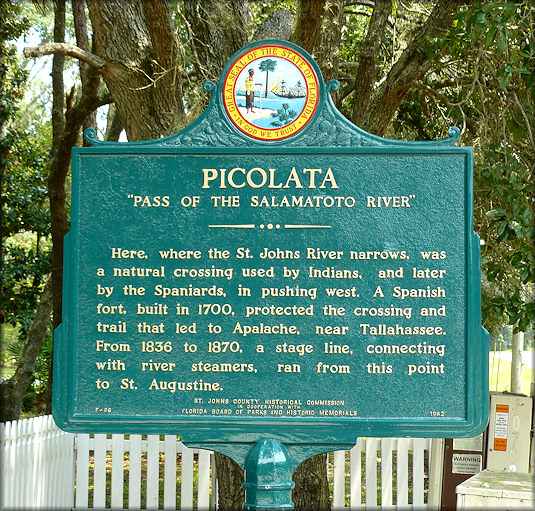
 On April 6,
2007 Ed Cavin and I (Harry Lee) set out to find an authentic specimen of the
type species of Daedalochila. We had a very specific quarry
in the cross-hairs - the snail that America's first native-born
conchologist named Polygyra auriculata, the Ocala Liptooth.
Say (1818: 276) wrote: "This curious species we found near St.
Augustine, East Florida, in a moist situation. They were observed in
considerable numbers ..." Say never illustrated his snail, but an
early engraving (Binney,
1857: pl. 47, fig. 1 - see image, left) was consulted. The text and figure gave us a bit of reassurance for the
feasibility of our mission, but, after nearly 200 years, we expected
to encounter a considerable loss of suitable habitat and other
environmental degradation. The expedition certainly wasn't a
pre-ordained slam-dunk. To improve our chances of success, a closer
look at the history of Say's discovery was in order.
On April 6,
2007 Ed Cavin and I (Harry Lee) set out to find an authentic specimen of the
type species of Daedalochila. We had a very specific quarry
in the cross-hairs - the snail that America's first native-born
conchologist named Polygyra auriculata, the Ocala Liptooth.
Say (1818: 276) wrote: "This curious species we found near St.
Augustine, East Florida, in a moist situation. They were observed in
considerable numbers ..." Say never illustrated his snail, but an
early engraving (Binney,
1857: pl. 47, fig. 1 - see image, left) was consulted. The text and figure gave us a bit of reassurance for the
feasibility of our mission, but, after nearly 200 years, we expected
to encounter a considerable loss of suitable habitat and other
environmental degradation. The expedition certainly wasn't a
pre-ordained slam-dunk. To improve our chances of success, a closer
look at the history of Say's discovery was in order.  the stretch of 208
from the Old City to Picolata. Accordingly we stopped the car at
fairly regular intervals along CR 208, debarking at whenever "a
moist situation" which seemed to have promise was seen. In the
course of three hours no less than ten stations were made. At one
station some dead shells were found (along with a well-nourished
Pygmy Rattlesnake), but none of the other stops produced any
specimens (of D. auriculata that is; a Water Moccasin was
encountered, however). In near exasperation, we returned to the one
productive spot and, after nearly an hour of searching - without
re-encountering the rattlesnake - a living specimen of the Ocala
Liptooth was found in the grassy swale bank along the road.
Measuring a little over a half-inch, this snail is included, along
with a dozen empty shells of its species, in the accompanying
montage of illustrations. We believe these shells qualify as
topotypes (specimens collected in the same place of the type lot), which
imparts a certain authenticity to their identity. Furthermore, they
are dead ringers for the lectotype, which Say brought back to
Philadelphia in the Spring of 1818 (ANSP
57066a; plate 4; Pilsbry, 1940: fig. 384-1 - see image, above, left). Also see:
the stretch of 208
from the Old City to Picolata. Accordingly we stopped the car at
fairly regular intervals along CR 208, debarking at whenever "a
moist situation" which seemed to have promise was seen. In the
course of three hours no less than ten stations were made. At one
station some dead shells were found (along with a well-nourished
Pygmy Rattlesnake), but none of the other stops produced any
specimens (of D. auriculata that is; a Water Moccasin was
encountered, however). In near exasperation, we returned to the one
productive spot and, after nearly an hour of searching - without
re-encountering the rattlesnake - a living specimen of the Ocala
Liptooth was found in the grassy swale bank along the road.
Measuring a little over a half-inch, this snail is included, along
with a dozen empty shells of its species, in the accompanying
montage of illustrations. We believe these shells qualify as
topotypes (specimens collected in the same place of the type lot), which
imparts a certain authenticity to their identity. Furthermore, they
are dead ringers for the lectotype, which Say brought back to
Philadelphia in the Spring of 1818 (ANSP
57066a; plate 4; Pilsbry, 1940: fig. 384-1 - see image, above, left). Also see:
